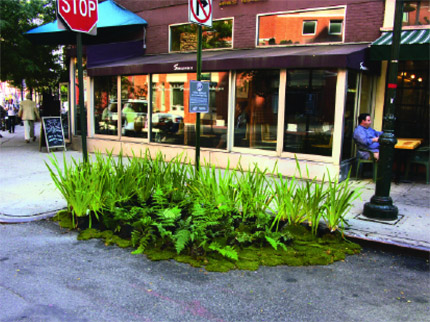environmental design
Avant-Garde Rx
A New clinic Offers activism and Art
by Sabine Heinlein / GSAS '07
A fter spending a semester in Berlin, where big trees line nearly every street and abundant parks feature thick woods and wildflowers, Moo Kyung Sohn (STEINHARDT '08) dreaded returning to New York’s concrete jungle. “The nature we see in the city is not real,” the undergrad says about Manhattan’s carefully planted plots. “It's an idea of nature that we made for ourselves.” So Sohn turned to NYU’s Environmental Health Clinic to assuage her green deprivation. The clinic, which officially opened last October at the Steinhardt School of Culture, Education, and Human Development, marries conceptual art with social and environmental activism. It welcomes appointments from “impatients,” individuals such as Sohn who are too anxious to wait for protracted legislative changes.
 This temporary "microswamp" offers a lush alternative to an East Village no-parking zone.
This temporary "microswamp" offers a lush alternative to an East Village no-parking zone.
"Coming to the clinic doesn't require that you are an environmental activist or a community organizer," explains founder Natalie Jeremijenko. "It's a way of coordinating diverse, local actions and making them amount to something significant." The goal is to create environmentalism that is mediagenic, publicly legible and, most of all, approachable and manageable by anyone. "People can actually do something," says Jeremijenko, who joined Steinhardt last semester as an assistant professor of visual art.
Jeremijenko first evaluates an impatient's concern and, upon diagnosis, issues a prescription for action. In Sohn's case, the "doctor" directed her to create "NoParks" in two of New York's many no-parking zones, such as in front of fire hydrants. One sunny day last September, passersby and local residents came to admire Sohn's micro-swamp with ferns, mosses, and rocks on East Ninth Street and her wildflower garden on Stuyvesant Street in the East Village. Her favorite visitors were a group of butterflies that made the wildflower garden their temporary home.
To help people tackle environmental issues often perceived as inaccessible and abstract, Jeremijenko plans to design a whole repertoire of such empowering actions. To folks who want to reclaim pedestrian power in a city known for heavy traffic, she might prescribe a unique pair of shoes that, through a spring in the heel, increase the wearers' stride by 20 to 40 percent. "It's a sensible shoe, but it's [also] about putting a spring in your step [and] treating gender differences," says Jeremijenko, whose artwork-cum-science projects have been exhibited at the Whitney Biennial in 1997 and 2006, the MoMA, the Guggenheim, and the Cooper-Hewitt Design Life Now: National Design Triennial 2006-07.
For all their high design, Jeremijenko's prescriptions are much more than fleeting eye candy. NoParks are an "engineered micro-landscape optimized for environmental problems," she says. A verdant island on the side of the road, a NoPark can capture the oily runoff from the road before it flows into the river and help reduce standing puddles that serve as breeding grounds for mosquitoes, which might eliminate the need for hazardous fumigation.
While Sohn's NoParks were temporary, the Environmental Health Clinic hopes to get permission from the Department of Transportation to permanently install them. The real thing will require the impatient to dig up asphalt and plant specific flora to filter out cadmium and hydrocarbon runoff. We might soon see NoParks sprout up all over New York, with Sohn leading the charge. "The clinic is not about giving you answers," she says. "It's about having you create your own."
phOTO © William Meyer







